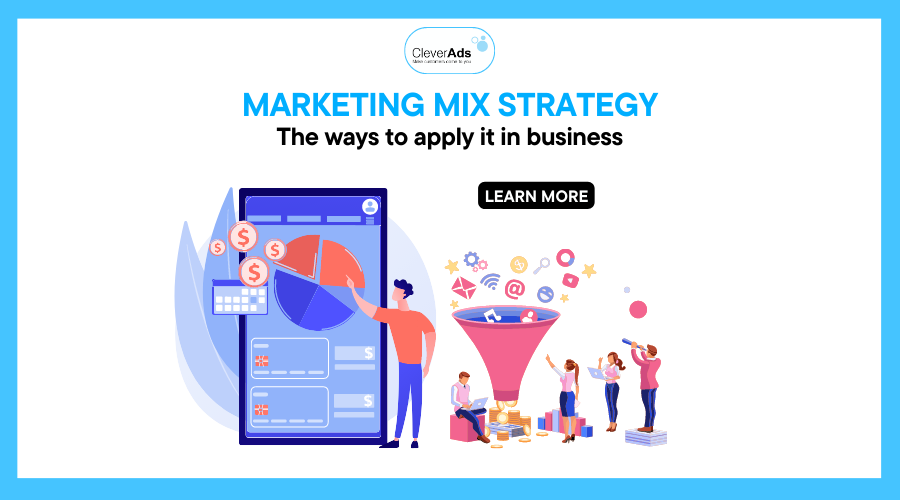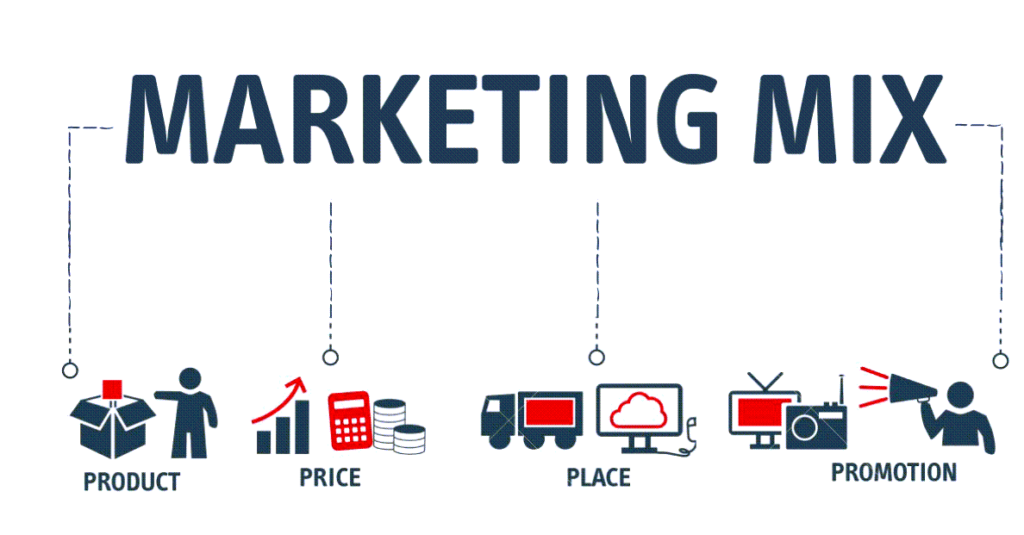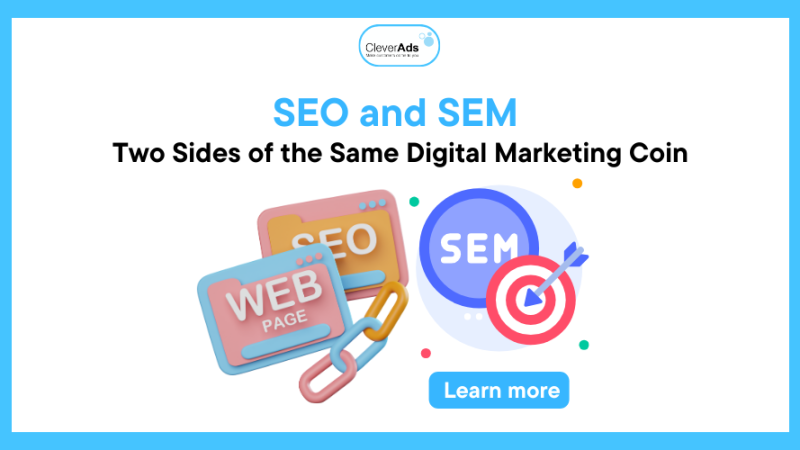Marketing Mix Strategy and the way to apply it in business

The marketing mix strategy is considered the key to success for any business in any industry, no matter how large or small. Any manager who wants to spread his product to the public pays attention to the marketing mix strategy. So what is the marketing mix strategy and how to apply them in the business? Let’s learn more deeply about CleverAds in the following article!
1. What is the marketing mix strategy?

The marketing mix strategy is one of the main factors that businesses need to carefully consider and implement wisely to be able to make successful marketing decisions for a product or service. The four Ps in the marketing mix include product, price, promotion, and place.
A marketing mix strategy provides a series of elements related to marketing activities for a product, which includes what customers want, how the product or service meets customer needs, and customer perception. about products and services, competitive advantages over competitors, and how the business interacts with its customers.
Since the introduction of the marketing mix in the 1950s, other extended Ps have been added in addition to the original four Ps: people, processes, and facilities. physical evidence.
Note:
- The marketing mix strategy is the core element for marketing a product or service
- The four Ps in the marketing mix include product, price, promotion, and place.
- The concept of the marketing mix strategy has been around since the 1950s. Over time, the marketing industry gradually developed, and the Ps were added in addition to the original 4Ps including people, processes, and facilities. tangible substance
Read more: What is Marketing Mix?
2. Understand more about marketing mix strategy and some examples
Neil Borden, a professor of advertising at Harvard University, was the man who made the concept of the marketing mix – later more widely known as the 4Ps – popularized in the 1950s. His 1964 publication “Concept Marketing Mix” outlines advertising tactics businesses can use to engage their consumers.
Decades later, the concepts that Professor Borden introduced are still applied by businesses to promote their products and services. Over time, the ideas and concepts the professor introduced were clarified and deepened by the main companies in the industry.
E. Jerome McCarthy, a marketing professor at Michigan State University, refined the concepts in Professor Borden’s book and named them the “four Ps” in marketing. McCarthy co-authored the book “Basic Marketing: A Management Approach” and brought these ideas to life.
By the time the ideas were established, they were helping businesses break down the physical barriers that prevent them from promoting their products more widely. Today, the Internet is a powerful tool to help companies overcome this barrier.
Read more: Effective Online Marketing Strategies For Your Business
Pro tip: Any successful marketing strategy should be controlled and adjusted over time. The marketing mix strategy that the business offers cannot last forever. It needs to be adjusted accordingly as your product grows and your customer base changes.
Some examples of marketing mix strategies include:
- Distribution will refer to where consumers buy a business’s product or where they learn and discover that product. Today’s consumers can learn about products and buy them through online channels, smartphone apps, retail outlets, or sales specialists.
- Price refers to the cost of a product or service. Determining a reasonable product price includes tasks such as analysis of competitors, customer needs, production costs, and the budget consumers are willing to spend various pricing models can be considered.
- The product a company offers depends on the type of company and the values they provide. For example, McDonald’s provides fast food in the simplest space, and they can expand their services will not go far from the core identity set out from the beginning.
- Sales promotion refers to the institution of specific advertising campaigns to reach the target market for the product. A company can use many different types of campaigns such as Instagram campaigns, public relations campaigns, placements, email campaigns, or a combination of different types of campaigns to reach the right target audience at the right place.
3. The Ps in the marketing mix strategy
3.1 Product
The first task that businesses want to implement in a marketing campaign is to understand their products. Who needs it? and why do they need it? What sets it apart from the competition? Maybe it’s because the product you’re offering is completely a new idea and so appealing in terms of design or functionality that consumers will have to own it as soon as they see it.
The task of marketers now is to identify the features and excellent points of the product and introduce it to consumers. Determining the exact characteristics of the product is also one of the main factors affecting the distribution process. Marketers need to understand the product life cycle so that they can make plans that are appropriate for each given life cycle.
Many of the successful products on the market are category leaders. For example, Apple was the first brand to create a touchscreen smartphone that could play music, surf the Internet, and make calls. Apple reported total iPhone sales of $71.6 billion in the first quarter of 2022. Which, in 2021, Apple reached the milestone of 2 billion iPhones sold.
Read more: What is a marketing plan? Developing a marketing plan for a new product
3.2 Price
Price is the amount a consumer is willing to pay for a product. Marketers will have to link price to the actual and perceived value of the products and consider supply costs, seasonal discounts, competitor prices, and retail prices to come up with a quote best pricing decisions.
In some cases, businesses can target consumer psychology by increasing the price of products to create a luxurious or exclusive look. Or businesses can also reduce prices so that more consumers can try and know about their products.
Marketers also need to determine exactly when and whether discounting is appropriate. A discount can attract more customers, but it can also give the impression to the customer that the product is less desirable than it originally was.
UNIQLO is headquartered in Japan and is a global clothing manufacturer. Like its competitors Gap and Zara, UNIQLO offers low-priced fashion apparel to young buyers.
What makes UNIQLO unique is its innovative product of high quality. To be able to produce products UNIQLO purchased fabrics in bulk, constantly searching for the highest quality raw materials at the lowest cost in the world. The company also directly negotiates with its manufacturers and builds strategic partnerships with innovative Japanese manufacturers.
UNIQLO also works with partner manufacturers to ensure its production process. It has given the company the flexibility to change to a more suitable production partner as needs change.
Finally, the company has a team of skilled textile workers, who are sent by the company to partner factories around the world to check the quality of the products.
3.3 Place – Distribution 
Does distribution include activities considering where the product will be sold, in brick-and-mortar stores or online? The objective of the businesses is to bring their products closer to the target customers, who are most likely to buy them.
That means only offering the product in certain stores and having it displayed in the best vantage point. The term placement also refers to the promotion of a product in the appropriate media to capture the attention of consumers.
For example, the 1995 film GoldenEye was the 17th installment in the James Bond franchise and the first to not feature Aston Martin. Instead, Bond actor Pierce Brosnan used a BMW Z3. Although the Z3 didn’t go on sale right after the movie premiered, BMW received 9,000 orders for the car in just a month after the movie hit theaters.
3.4 Promotion
The main objective of the promotion is to communicate to the consumers that they need this product at the right price. Promotion includes advertising, public relations, and overall communication strategy to introduce the product.

Marketers tend to combine multiple tools to reach their target audience. In the digital age, for example, the components of distribution and promotion are transformed online in equal amounts as offline. These can include product placement on the company’s website or social media.
Read more: How to build a marketing communication plan to attract customers
A prime example is the Swedish vodka brand Absolut which sold only 10,000 cases of vodka in 1980, but by 2000 the number had reached 4.5 million cases thanks in part to an aggressive advertising campaign. their icon. The campaign images highlight the brand’s signature bottle shape: bottles with halo, bottles made of stone, or bottles in the shape of trees standing on a ski slope. To date, Operation Absolut remains one of the longest-deployed campaigns of all time, from 1981 to 2005.
4. How to apply the marketing mix strategy in the business
The marketing mix strategy is the core factor affecting the victory of the product in the future. Businesses need to analyze and accurately identify each element in the 4Ps strategy. However, there is no need to worry when the elements overlap because it is inevitable.
First, carefully analyze the product that the business intends to implement in the marketing plan. What makes the product different from the competition in the market? Is it because the material is sustainable, eco-friendly, or because the product is easier to use and more durable? Identify the features that will make your product attractive to your target consumers.
Then do a thorough analysis of the right price for the product. It’s not simply the cost of production plus the profit margin. The business can position it as a premium, luxury product or as a lower-priced alternative to other products on the market.
Distribution involves determining the type of store that will display products: online or physical stores, thereby providing products tailored to consumer needs.
Promotion should be considered in the context of the business’s target customers. Products can appeal to a wide variety of customers such as discerning young consumers or buying and selling professionals or even promotion hunters. Your communication strategy needs to reach the right audience with the right message.
5. When do 4Ps become 7Ps
Focusing on the four Ps – product, price, distribution, and promotion – has been a core marketing tenet since the 1950s. Recently, however, the three newly added Ps have broadened the scope further. of marketing in the 21st century.
“In the past, people only focused on the quality of the product, but in modern times, they also pay attention to the attitude of the sales staff and customer service or more. Social media influencers and corporate viral media campaigns
Consumers increasingly demand that the delivery process be fast and efficient: deliver totally what they want, just in time when they can get it.
Physical facilities are probably the most modern of the seven P’s. If you’re selling diamond jewelry on a website, you need to provide enough information so consumers can be sure. that this is a legally established business and will deliver as promised and not a scam.
In addition, a professionally designed website with easy-to-use functions, providing all the necessary information and the physical address of the company with professional packaging and efficient delivery service, all of which are very influential in convincing consumers that your products are not only good but also real.
Read more: 7Ps in marketing – the most effective strategy for the service industry
6. EPILOGUE
The marketing mix consists of four core elements: product, price, distribution, and promotion, and three extension elements: people, processes, and physical facilities. These are all important factors that are directly involved in the planning and marketing of a product or service, and they interact a lot with each other. Businesses need to carefully consider all factors to be able to approach a comprehensive marketing mix strategy.



